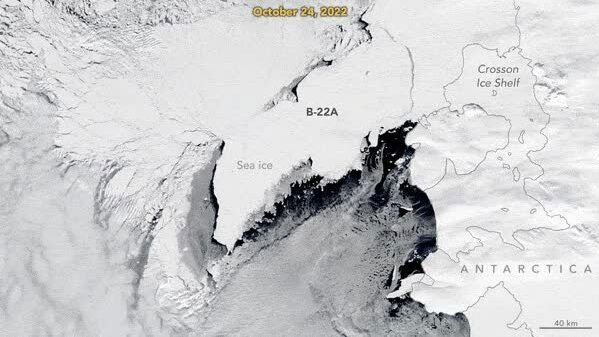New satellite images from NASA reveal that the B-22A iceberg, which spans approximately 3,000 square kilometers—twice the size of Houston—has begun to drift away from Antarctica.
B-22A is the largest remaining piece of B-22, a massive ice block the size of Rhode Island, that detached from the Thwaites Glacier—also known as the Doomsday Glacier—in March 2002. During this time, B-22A retained a significant amount of its original ice and occupies an area of about 3,000 km2, which is roughly twice the area of Houston, Texas.

The B-22A iceberg has been drifting away from Antarctica from October 24, 2002, to March 26, 2023. (Photo: NASA’s Earth Observatory).
After detaching from the glacier, B-22A floated freely off the coast of Antarctica until it became lodged on a raised part of the seabed in 2012. The iceberg is located only about 53 kilometers from its original separation point, meaning it has been moving at an average rate of 2.6 kilometers per year. This is one of the slowest average movements recorded for any iceberg, according to NASA.
However, B-22A has now been “liberated”, Live Science reported on April 18. Images from NASA’s Terra and Aqua satellites reveal that the iceberg began moving again on October 24, 2022, according to the Earth Observatory. As of March 26 of this year, B-22A has drifted approximately 175 kilometers northwest, meaning it traveled over three times farther in these six months compared to the previous 247 months.
Scientists are particularly concerned about B-22A moving away from Antarctica because this could potentially affect the stability of the Thwaites Glacier. According to the Earth Observatory, stationary icebergs can cool the surrounding waters, helping to stabilize the glacier and other ice masses, but they can also harm marine ecosystems if they become trapped further out.
Although it is melting slower than initially predicted, the Thwaites Glacier remains in a precarious state, and a new study suggests that the melting rate may accelerate in the future. Therefore, experts need to monitor any changes that may occur as an iceberg shifts.
Scientists will track the B-22A’s departure from Antarctica to see where and when it will break apart. Icebergs can discharge massive amounts of freshwater as they melt, impacting ecosystems and ocean currents. For example, A68—a massive iceberg with a surface area of approximately 6,000 km2 that broke away from the Larsen C ice shelf in Antarctica in 2017—released around 907 billion tons of water into the ocean over three years.





















































